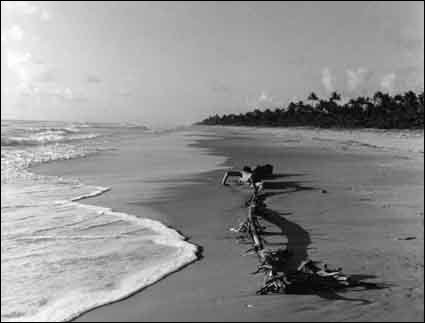World Watching
17.09. - 8.10. 1997.

Foto ©1997 Wanda Michalak.
Trzy praktyki, ciało, krajobraz.
Roland Barthes w Camera Lucida (1980): "staję się w procesie 'pozowania', natychmiast stwarzam dla siebie nowe ciało, przemieniam się zawczasu w wyobrażenie. Ta transformacja ma charakter aktywny: czuję, że Fotografia stwarza moje ciało lub je uśmierca [...]"
W cyklu zdjęć World Watching nagie ciało umiejscawia się w krajobrazie. A raczej w krajobrazach: Brazylii, Walii, Australii, Irlandii... Z punktu widzenia patrzącego na te zdjęcia nie jest bez znaczenia, że to umiejscawiające się ciało i komponująca zdjęcie osoba, to dwie funkcje autorki "robiącej" zdjęcie. Tak więc proces "pozowania" ciała jest pierwotnie pomyślany poprzez fotograficzny kadr - potem dopiero uwidoczniony (może ze spontanicznymi korektami) i utrwalony na filmie.
Ciało, zwłaszcza ciało pozbawione wszelkiego okrycia, przybiera rozmaite kształty i pozy w spotkaniu z naturą. Wanda Michalak prowadzi tu grę na kilku rejestrach. Piękno zachodzącego słońca jest powitane pięknem pozy, harmonijnie i z zaufaniem umieszczonej w strefach ziemi, wody, nieba i światła. "Religia ciała", jak pisano o tych zdjęciach? Być może, ale zarazem jego "fotogenetyka", określająca tryb umiejscawiania (się) ciała w takim, a nie innym otoczeniu: ciało jak kamień pośród kamieni na plaży (odpływ, Normandia, "Kobieta z wydm"?); uchwycona tubylka pośród mrocznych palm; dojście do drzewa w tropikalnym lesie...
Jest zatem ciało w pewnym stanie mimikry, ciało wchłonięte - przez krajobraz lub pamięć o obrazie. Lecz jest tu także ciało wchłaniające krajobraz. Postać pomnikowo umiejscowiona na kamiennym szczycie, dosiadająca sterczącej skały, podnosząca maszt oblepionego wodorostami drzewa. Wszystkie te czynności nie mają na celu mimikry - raczej zawładnięcie obszaru.
Barthes w Camera Lucida: "zauważyłem, że fotografia może być przedmiotem trzech praktyk (czy też trzech emocji lub trzech intencji): robić, poddawać się, patrzeć". Cykl World Watching jest na pewien sposób efektem wymiany pomiędzy tymi postawami i emocjami, sposobem stawiania pytań, doświadczania odpowiedzi - i spoglądania na Fotografię.
Piotr Rypson, Amsterdam, IX '97

Foto ©1997 Wanda Michalak.
Three Practices, a Body, a Landscape
Roland Barthes in his "Camera Lucida" (1980): "I come into being in the process of "posing", I immediately create a new body for myself, I change beforehand into an imaginary person. This transformation is of an active nature: I feel that Photography creates or kills my body [...]".
In the "World Watching" series a naked body is placed within a landscape. Or rather within the landscapes of Brazil, Wales, Australia and Ireland... From the point of view of a person watching these pictures it is not unsignificant that the body and the person composing the photograph are only two functions of the authorss "taking" the picture. Thus the process of the "posing" of the body is originally conceived by the photographic frame and only later made visible (perhaps with some spontaneous corrections) and recorded on film.
A body, especially devoid of all covering, takes on various poses and shapes in contact with nature. Wanda Michalak plays her game on several levels as far as this problem is concerned. The beauty of the setting sun is greeted by the beauty of a pose, harmoniously and with confidence placed among the spheres of the earth, the water, the sky and the light. "Religion of the body", as critics have written about these photographs? Perhaps, but also its "photogenetics", defining the process of placing the body (or the process of the body placing itself) in a given and not any other environment: the body like a stone among other stones on the beach (the ebb, Normandy, "A Woman of the Dunes"?); a native woman caught among dark palms; approaching a tree in a tropical forest...
So the body is in a certain state of mimicry, the body is absorbed - by a landscape or a memory of an image. But we have here also bodies absorbing landscapes. A statue-like figure placed on a rocky peak, a figure mounting a protruding rock, or lifting the mast of a tree covered by fucus. Mimicry is not the aim here - the aim is rather to dominate over a certain territory.
Barthes in "Camera Lucida": "I noticed that photography may be the object of three kinds of practice (or three emotions or intentions): doing, surrendering and watching". The "World Watching" series is in a way the result of exchange between these standpoints and emotions, it is a means of asking questions, experiencing answers - and looking at Photography.
Piotr Rypson, Amsterdam, September 1997
translated by Maciej Świerkocki

Foto ©1997 Wanda Michalak
Wanda Bernadetta Michalak
Urodzona w Warszawie. Mieszka i pracuje w Amsterdamie.
Born in Warsaw. Live and work in Amsterdam.Edukacja / Education:
Carrington Polytechnic Design School
Auckland, New ZealandWybrane wystawy / Selected exhibitions:
1990 "Portraits" Auckland (New Zealand)
1991 "The Four elements" Group ExhibitionGallery De Moor, Amsterdam, (Netherlands)
1992 "The Moor Inside Out", Photo Project De Moor, Amsterdam
1992 "Selected Works", Gallery Spectrum, Amsterdam
1993 "Double Exhibition", Galeria Panorama - Patio,Warsaw (Poland)
1993 "Travel Photography - Ghana", De Moor, Amsterdam
1994 "New Horizons", Lubjana (Slovenia)
1994 "Natural Connections", De Moor, Amsterdam
1995 "Double Portraits", Amsterdam Centrum voor Fotograph
1995 "Portraits of Slavic Women", Double Exhibition, Hoorn (Netherlands)
1996 "Project 17 x 17 x 17", Group Exhibition, ACF, Amsterdam
1997 "Venus Nova", Studio "M." Bożeny Marki, Warsaw
Foto ©1997 Wanda Michalak
Copyright ©1997 Galeria FF ŁDK, Wanda Michalak, Piotr Rypson.